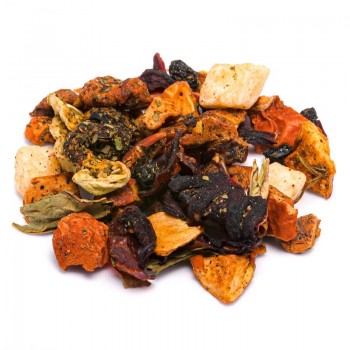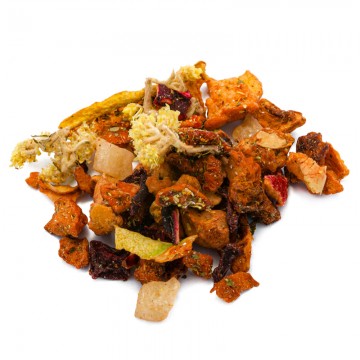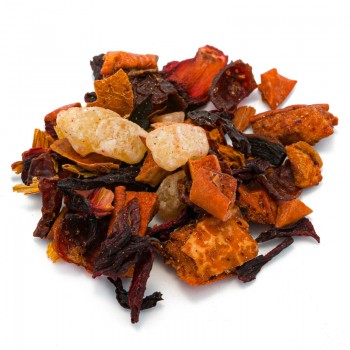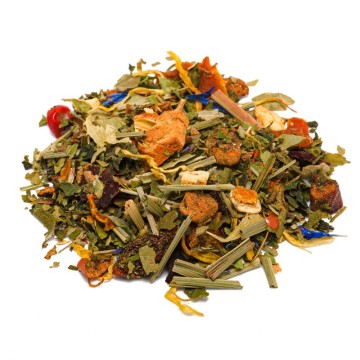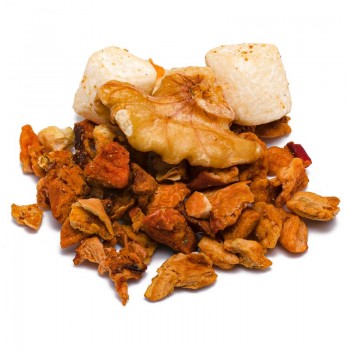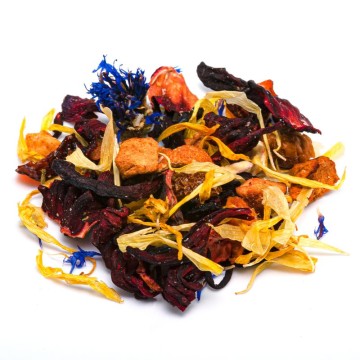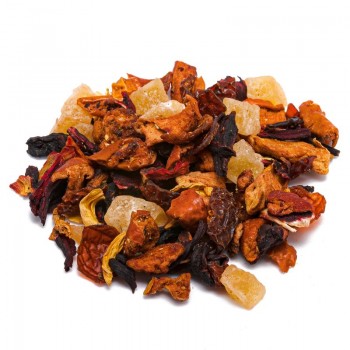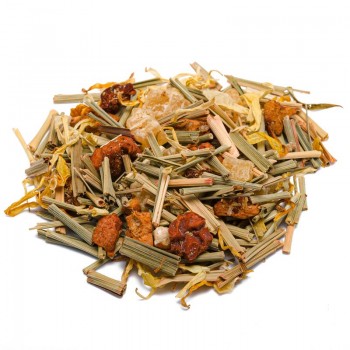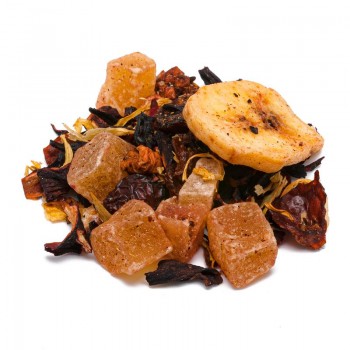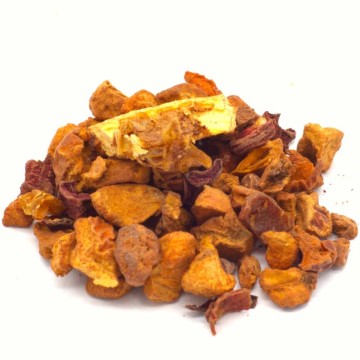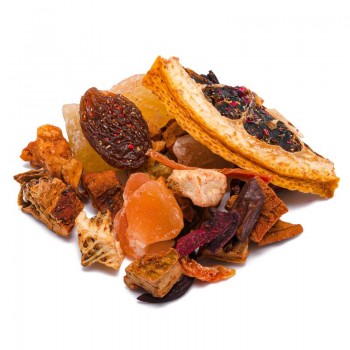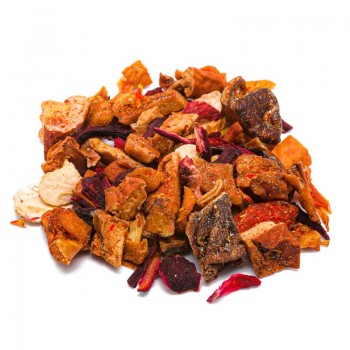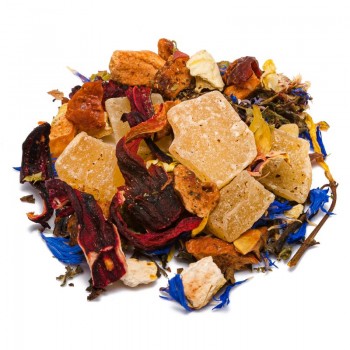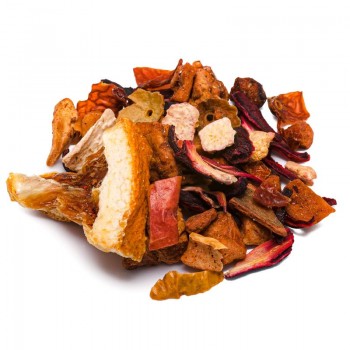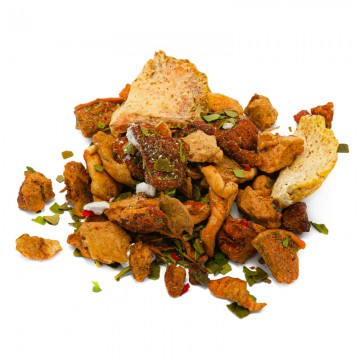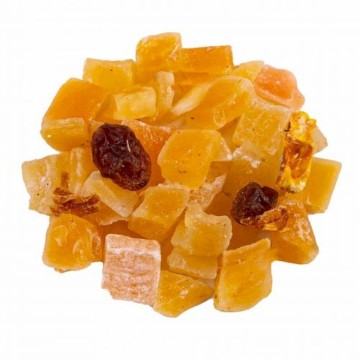This combination of exquisite products combines the spicy flavor of ginger with the sweet aroma of mango, creating a delicious contrast. For lovers of aromatic and spicy ginger, the mixture is delicious as well as beneficial. The mango in this composition softens and sweetens the natural energy of the ginger, while the mixture with the apple becomes particularly refreshing. The herbaceous tone of the nettle leaves makes the finishing touch to this unique and revitalizing drink. The mango and ginger infusion arrives on the palate deliciously fruity and original, a true pleasure of taste, ideal at any time of the day.
Mango and ginger infusion: properties and benefits
A spicy and intense blend, which supports digestion and the body's well-being thanks to these ingredients. Mango and ginger are elements already known to classical Ayurvedic medicine, which combined different properties to heat and facilitate the transit of food. Ginger helps boost a healthy digestive system, relieving symptoms of gastrointestinal digestive difficulties, such as bloating and nausea. Its properties to calm stomach pain also promote the correct absorption of food, avoiding bloating and intestinal gas after eating too much.
In the case of indigestion, it counteracts stomach inflammation and acidity also thanks to nettle which balances the acid/alkaline ratio in the body. The infusion based on mango and ginger gives purifying properties, promoting the correct assimilation and combustion of fats. Apple also helps detoxification, digestion and weight loss - if the infusion is included in a valid weight-loss diet. The infusion of the components (root, fruit and leaves) is useful for purifying the intestines and bladder. By taking this infusion you obtain various antioxidants and mango vitamins. Beneficial active ingredients that strengthen the immune system thanks to vitamin C, magnesium and other minerals made available by ginger root and fruits (mango and apple).
The mixture is perfect hot, to beat the cold and irritation of the mucous membranes as a natural support for the symptoms of nasal congestion and colds. It is a soothing drink thanks to the volatile oils, which give natural anti-inflammatory properties, useful for calming irritation, headaches and menstrual pain. The vitamin C content is suitable for counteracting colds and other antioxidants protect the mucous membranes.
The infusion mix will also promote sweating when necessary, promoting proper blood circulation. Ginger has traditionally been used to promote correct peripheral microcirculation - useful in the case of cold hands and feet. Mango and ginger pair well with nettle leaves which represent a concentrate that provides calcium, iron, potassium and magnesium. Elements useful for calming the nervous system, facilitating relaxation and reinvigorating. Together with mango, it provides beta-carotene and B vitamins, for a synergistic effect that increases the properties of each element.
Origins and history of cultivation
The mango tree originally from India, is now cultivated in all tropical areas. Since ancient times, it had great importance in the populations who followed the Hindu religion, for which the mango was sacred. In many legends it was a plant used to decorate temples and the fruits were considered beneficial. The current word mango comes from the phrase maangai, which transformed into the Portuguese language manga and then mango.
In the 4th century BC. It was introduced in other countries outside India, including Southeast Asia and East Africa. It slowly spread to Europe and the Portuguese exported mango seeds to South America. Today in Europe it is cultivated in Spain and Italy (Sicily and Calabria).
The root of the ginger plant (the underground stem called the rhizome) has been used in many herbal traditions since ancient times. Since the plant does not grow easily in the wild, its origins are uncertain. It is believed that Indians and Chinese have used ginger as a root tonic for around 3000 years to cure various ailments. In Indian Ayurveda medicine, ginger is known as a wonder, used for a wide variety of health treatments, especially supporting proper digestion. Historically, ginger root was also one of the herbs known for joint health as a natural anti-inflammatory. It arrived in Europe imported from India and was highly appreciated in the Roman Empire already 2000 years ago for its products.medicinal properties.
Ginger was a highly sought after product in Europe, traded by Arab merchants. Today the plant is cultivated in all tropical areas and India which is the largest producer. Today, ginger is known as part of a family of plants that includes cardamom and turmeric, very well-known and used spices. The current Italian name dates back to the Greek word ziggiberis and Latin zinziberi. Nettle is a perennial herbaceous plant that grows wild, often considered a weed. Widespread across many continents - Europe, Asia, North Africa and North America - nettle is an edible plant and for this reason its use has been recorded since the Bronze Age (3000 BC - 1200 BC) in many ways. It has nutritional and medicinal properties that have made it famous over time. According to testimonies, even in the 1st century BC, the stinging properties of nettle helped Julius Caesar's troops to remain alert during the night. Nettle fiber has also been used as a fabric, a substitute for cotton yarn when this material was not available. On a herbal level, the leaves have been used to treat inflammation from arthritis, rheumatism and allergic rhinitis. It is cultivated for food use, to create decoctions and infusions, and also to obtain fertilizers and insecticides.
Fruits and flowers
Mango is the fruit of the Mangifera plant, belonging to the Anacardiaceae family. It is an evergreen that displays pointed leaves and pinkish-white or yellowish flowers. The fruits are few compared to the flowers, and require three to six months to ripen, depending on the variety of Mangifera cultivated. They are born as drupe fruits with peels with colors from yellow to green to red-green - they are variable in size. The pulp is tender and yellow. The Zingiber officinalis plant is a flowering plant belonging to the Zingiberaceae family native to south-east Asia. The rhizome, which is the underground part of the stem, is the one commonly used for consumption and which provides the spice. Ginger can be used fresh, dried, powdered, or in the form of oil or juice. The Malus domestica plant of the Rosaceae family gives us apples. It is a tree native to Asia, probably in Kazakhstan. The apple tree is now widespread throughout the planet, as a tree approximately 3-10 m high, with an expansive and thick foliage. The fruits vary in color and in many varieties, and have been used in human nutrition for millennia. Nettle has the botanical name of Urtica dioica L., a perennial herbaceous plant. It is usually not very tall, between 30 and 250 centimeters and shows little branching. It also spreads thanks to the very branched creeping rhizome, and gives large, serrated and sharp leaves. It has hairs that release an irritating and stinging fluid (causing burning and itching) when they break.
Nutritional values of mango and ginger infusion
The main active ingredients are nutrients such as vitamins (B3 and B6, C) and minerals - iron, potassium, magnesium, phosphorus, zinc. At the level of protective compounds with antioxidant properties, they include mangaferin, anthocyanins, shogaols and gingerols; polyphenols and carotenoids. How to use the ingredients in the infusion
The infusion is obtained by placing approximately 3-5 grams of the mango and ginger mixture in a cup (250 ml), with water at 100 °C. Leave to infuse for 10 to 12 minutes before drinking. Add honey or sugar, if desired.
Mango and ginger infusion: side effects and contraindications
Even if the infusion brings benefits, it is necessary to respect the recommended doses and not exceed the intake of the drink for too long periods. Excessive consumption can cause stomach irritation and acidity, constipation, headaches.

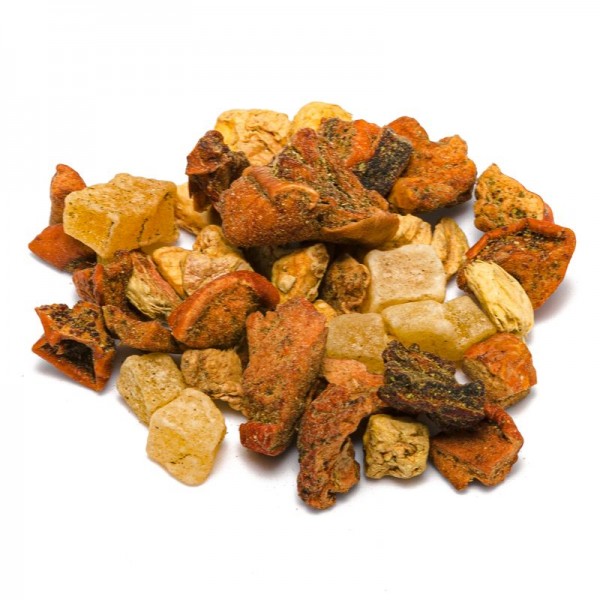









 No reward points for this product.
No reward points for this product.
